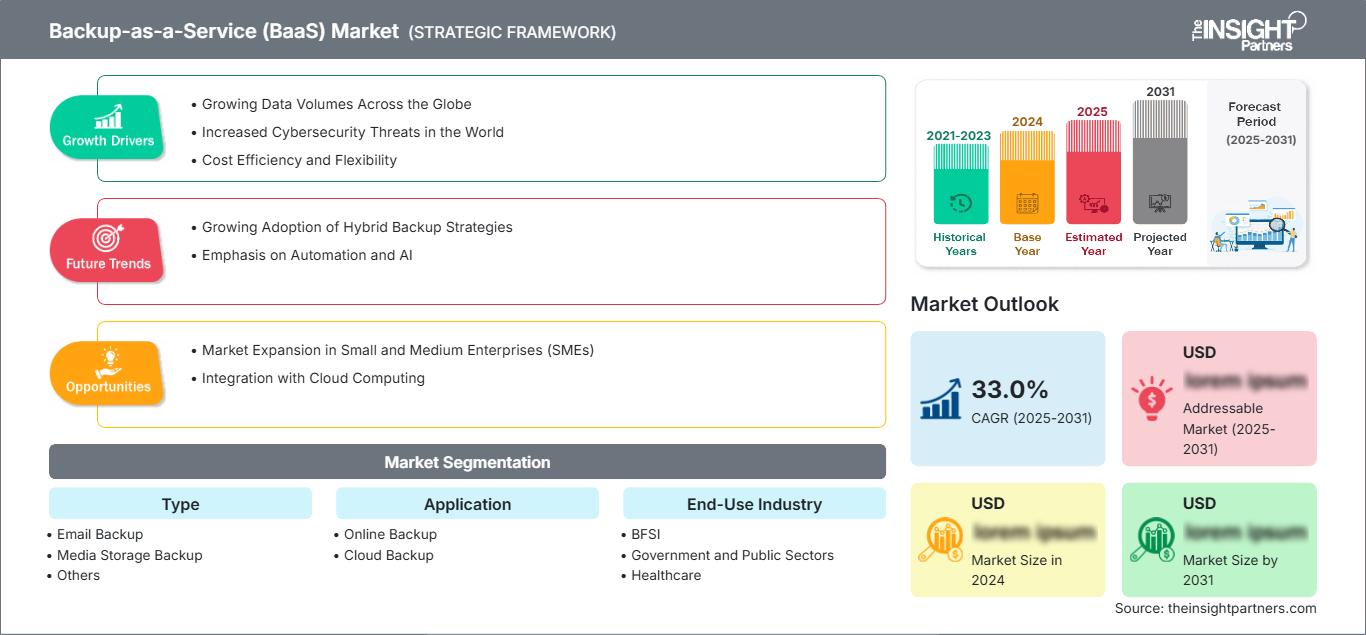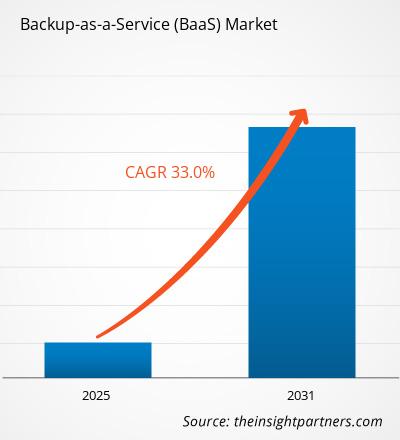Der Markt für Backup-as-a-Service (BaaS) wird voraussichtlich zwischen 2025 und 2031 eine durchschnittliche jährliche Wachstumsrate (CAGR) von 33,0 % verzeichnen, wobei die Marktgröße von XX Millionen US-Dollar im Jahr 2024 auf XX Millionen US-Dollar im Jahr 2031 anwachsen wird.
Der Bericht ist segmentiert nach Typ (E-Mail-Backup, Medienspeicher-Backup, Sonstige); Anwendung (Online-Backup, Cloud-Backup); Endverbraucherbranche (BFSI, Regierung und öffentlicher Sektor, Gesundheitswesen, Fertigung, Medien und Unterhaltung, Telekommunikation und IT, Sonstige). Die globale Analyse ist weiter nach regionalen und wichtigen Ländern aufgeschlüsselt. Der Bericht bietet den Wert in USD für die obige Analyse und Segmente.
Zweck des Berichts
Der Bericht „Backup-as-a-Service (BaaS) Market“ von The Insight Partners zielt darauf ab, die aktuelle Situation und das zukünftige Wachstum sowie die wichtigsten treibenden Faktoren, Herausforderungen und Chancen zu beschreiben. Dadurch erhalten verschiedene Geschäftsinteressenten Einblicke, beispielsweise:
- Technologieanbieter/-hersteller: Um die sich entwickelnde Marktdynamik zu verstehen und die potenziellen Wachstumschancen zu kennen, sodass sie fundierte strategische Entscheidungen treffen können.
- Investoren: Um eine umfassende Trendanalyse hinsichtlich der Marktwachstumsrate, der finanziellen Marktprognosen und der Chancen entlang der Wertschöpfungskette durchzuführen.
- Regulierungsbehörden: Um Richtlinien und Überwachungsaktivitäten auf dem Markt zu regulieren, mit dem Ziel, Missbrauch zu minimieren, das Vertrauen der Investoren zu wahren und die Integrität und Stabilität des Marktes aufrechtzuerhalten.
Backup-as-a-Service (BaaS) Marktsegmentierungstyp
- E-Mail-Backup
- Medienspeicher-Backup
- Sonstige
Anwendung
- Online-Backup
- Cloud-Backup
Endverbraucherbranche
- BFSI
- Regierung und öffentlicher Sektor
- Gesundheitswesen
- Fertigung
- Medien und Unterhaltung
- Telekommunikation und IT
- Sonstige
Geografie
- Nordamerika
- Europa
- Asien-Pazifik
- Süd- und Mittelamerika
- Naher Osten und Afrika
Sie erhalten kostenlos Anpassungen an jedem Bericht, einschließlich Teilen dieses Berichts oder einer Analyse auf Länderebene, eines Excel-Datenpakets sowie tolle Angebote und Rabatte für Start-ups und Universitäten.
Backup-as-a-Service (BaaS)-Markt: Strategische Einblicke

-
Holen Sie sich die wichtigsten Markttrends aus diesem Bericht.Dieses KOSTENLOSE Beispiel umfasst Datenanalysen, die von Markttrends bis hin zu Schätzungen und Prognosen reichen.
Wachstumstreiber für den Backup-as-a-Service (BaaS)-Markt
- Weltweit wachsende Datenmengen: Das exponentielle Wachstum der von Unternehmen verschiedenster Branchen generierten Daten ist ein Haupttreiber des Backup-as-a-Service (BaaS)-Marktes. Da Unternehmen durch Betriebsabläufe, Transaktionen und Kundeninteraktionen enorme Datenmengen ansammeln, steigt der Bedarf an effektiven und skalierbaren Backup-Lösungen. BaaS bietet Unternehmen eine zuverlässige Möglichkeit, ihre kritischen Daten zu speichern, zu schützen und wiederherzustellen, ohne dass eine komplexe lokale Backup-Infrastruktur verwaltet werden muss. Diese Nachfrage nach effizienten Datenmanagementlösungen ermutigt Unternehmen, BaaS als Mittel zum Schutz ihrer Informationen vor Datenverlust einzusetzen und so Geschäftskontinuität und die Einhaltung gesetzlicher Standards zu gewährleisten.
- Weltweite Zunahme der Cybersicherheitsbedrohungen: Die zunehmende Häufigkeit und Raffinesse von Cyberangriffen wie Ransomware und Datenschutzverletzungen sind wichtige Treiber des BaaS-Marktes. Unternehmen sind sich zunehmend der Schwachstellen ihrer Datensicherheitssysteme und der potenziellen finanziellen Schäden und Reputationsschäden durch Datenverlust bewusst. BaaS-Lösungen bieten zuverlässigen Schutz vor solchen Bedrohungen, indem sie automatisierte Backups, Verschlüsselung und schnelle Wiederherstellungsoptionen bieten. Da Unternehmen ihre Cybersicherheit verbessern und das Risiko von Datenverlust minimieren möchten, nimmt die Nutzung von BaaS stetig zu und macht es zu einem wesentlichen Bestandteil moderner Datenschutzstrategien.
- Kosteneffizienz und Flexibilität: Unternehmen suchen ständig nach Möglichkeiten, ihre Kosten zu optimieren und gleichzeitig ein effektives Datenmanagement aufrechtzuerhalten. BaaS bietet eine kostengünstige Alternative zu herkömmlichen Backup-Lösungen, da keine hohen Vorabinvestitionen in Hard- und Software erforderlich sind. Mit BaaS zahlen Unternehmen nur für den tatsächlich genutzten Speicherplatz und haben so mehr Flexibilität bei Budgetierung und Ressourcenzuweisung. Die Skalierbarkeit von BaaS-Lösungen ermöglicht es Unternehmen zudem, ihre Backup-Kapazitäten an ihren wachsenden Datenbedarf anzupassen. Das macht sie zu einer attraktiven Option für Unternehmen, die ihre Abläufe rationalisieren und ihren IT-Aufwand senken möchten.
Zukünftige Trends im Back-up-as-a-Service (BaaS)-Markt
- Zunehmende Nutzung hybrider Backup-Strategien: Ein wichtiger Trend im BaaS-Markt ist die zunehmende Präferenz für hybride Backup-Strategien, die lokale und Cloud-basierte Lösungen kombinieren. Unternehmen erkennen die Vorteile sowohl lokaler als auch externer Backups, um Datenredundanz und schnelle Wiederherstellung zu gewährleisten. Dieser Ansatz ermöglicht es Unternehmen, Leistung und Sicherheit in Einklang zu bringen und gleichzeitig unterschiedlichen Compliance-Anforderungen gerecht zu werden. Da Unternehmen ihre Backup-Strategien optimieren möchten, wird die Nachfrage nach flexiblen hybriden BaaS-Lösungen voraussichtlich steigen und das Serviceangebot im Markt beeinflussen.
- Schwerpunkt auf Automatisierung und KI: Ein weiterer aufkommender Trend im BaaS-Markt ist die zunehmende Bedeutung von Automatisierung und künstlicher Intelligenz (KI) zur Verbesserung von Backup-Prozessen. Automatisierung optimiert Backup-Pläne, reduziert menschliche Fehler und gewährleistet konsistente Datenschutzpraktiken. Gleichzeitig können KI-Technologien Backup-Daten analysieren, um Anomalien oder potenzielle Fehler zu identifizieren und so proaktive Maßnahmen zur Risikominimierung zu ermöglichen. Da Unternehmen in ihren Datenmanagementstrategien Wert auf Effizienz und Zuverlässigkeit legen, wird die Integration von Automatisierung und KI in BaaS-Lösungen die Marktentwicklung weiterhin prägen und zu verbesserten Serviceangeboten und höherer Kundenzufriedenheit führen.
Marktchancen für Backup-as-a-Service (BaaS)
- Marktexpansion in kleinen und mittleren Unternehmen (KMU): Der BaaS-Markt bietet erhebliche Wachstumschancen für kleine und mittlere Unternehmen (KMU). Viele KMU stehen aufgrund begrenzter Ressourcen und Fachkenntnisse vor der Herausforderung, effektive Backup-Lösungen zu implementieren. BaaS-Anbieter können ihre Dienste an die spezifischen Bedürfnisse dieser Unternehmen anpassen und kostengünstige und einfach zu verwaltende Backup-Optionen anbieten. Da das Bewusstsein für Datenschutz bei KMU wächst, dürfte auch die Nachfrage nach BaaS steigen. Dies stellt ein lukratives Marktsegment für Serviceanbieter dar, die ihre Reichweite erweitern und neue Kunden gewinnen möchten.
- Integration mit Cloud Computing: Der anhaltende Trend hin zu Cloud Computing bietet zahlreiche Chancen für den BaaS-Markt. Da Unternehmen ihre Abläufe zunehmend in die Cloud migrieren, kann die Integration von Backup-Lösungen in bestehende Cloud-Infrastrukturen die Datenschutz- und Wiederherstellungsprozesse verbessern. BaaS-Anbieter können Partnerschaften mit Cloud-Service-Providern nutzen, um nahtlose Lösungen anzubieten, die auf die Cloud-Strategien ihrer Kunden abgestimmt sind. Diese Integration verbessert nicht nur die Betriebseffizienz, sondern bietet auch Möglichkeiten für Cross- und Upselling zusätzlicher Services und steigert so das Umsatzwachstum der BaaS-Anbieter.
Backup-as-a-Service (BaaS)-Markt
Die Analysten von The Insight Partners haben die regionalen Trends und Faktoren, die den Backup-as-a-Service (BaaS)-Markt im Prognosezeitraum beeinflussen, ausführlich erläutert. In diesem Abschnitt werden auch die Marktsegmente und die geografische Lage von Backup-as-a-Service (BaaS) in Nordamerika, Europa, im asiatisch-pazifischen Raum, im Nahen Osten und Afrika sowie in Süd- und Mittelamerika erläutert.Umfang des Marktberichts zu Backup-as-a-Service (BaaS)
| Berichtsattribut | Einzelheiten |
|---|---|
| Marktgröße in 2024 | US$ XX million |
| Marktgröße nach 2031 | US$ XX Million |
| Globale CAGR (2025 - 2031) | 33.0% |
| Historische Daten | 2021-2023 |
| Prognosezeitraum | 2025-2031 |
| Abgedeckte Segmente |
By Typ
|
| Abgedeckte Regionen und Länder |
Nordamerika
|
| Marktführer und wichtige Unternehmensprofile |
|
Dichte der Marktteilnehmer im Bereich Backup-as-a-Service (BaaS): Auswirkungen auf die Geschäftsdynamik verstehen
Der Markt für Backup-as-a-Service (BaaS) wächst rasant. Die steigende Nachfrage der Endnutzer ist auf Faktoren wie veränderte Verbraucherpräferenzen, technologische Fortschritte und ein stärkeres Bewusstsein für die Produktvorteile zurückzuführen. Mit der steigenden Nachfrage erweitern Unternehmen ihr Angebot, entwickeln Innovationen, um den Bedürfnissen der Verbraucher gerecht zu werden, und nutzen neue Trends, was das Marktwachstum weiter ankurbelt.

- Holen Sie sich die Backup-as-a-Service (BaaS)-Markt Übersicht der wichtigsten Akteure
Wichtige Verkaufsargumente
- Umfassende Abdeckung: Der Bericht analysiert umfassend Produkte, Dienstleistungen, Typen und Endnutzer des Backup-as-a-Service (BaaS)-Marktes und bietet einen ganzheitlichen Überblick.
- Expertenanalyse: Der Bericht basiert auf dem umfassenden Verständnis von Branchenexperten und Analysten.
- Aktuelle Informationen: Der Bericht gewährleistet Geschäftsrelevanz durch die Berichterstattung über aktuelle Informationen und Datentrends.
- Anpassungsoptionen: Dieser Bericht kann an spezifische Kundenanforderungen angepasst werden und passt sich optimal an die Geschäftsstrategien an.
Der Forschungsbericht zum Backup-as-a-Service (BaaS)-Markt kann daher dazu beitragen, die Branchensituation und die Wachstumsaussichten zu entschlüsseln und zu verstehen. Obwohl es einige berechtigte Bedenken geben mag, überwiegen die Vorteile dieses Berichts tendenziell die Nachteile.
- Historische Analyse (2 Jahre), Basisjahr, Prognose (7 Jahre) mit CAGR
- PEST- und SWOT-Analyse
- Marktgröße Wert/Volumen – Global, Regional, Land
- Branchen- und Wettbewerbslandschaft
- Excel-Datensatz
Aktuelle Berichte
Erfahrungsberichte
Grund zum Kauf
- Fundierte Entscheidungsfindung
- Marktdynamik verstehen
- Wettbewerbsanalyse
- Kundeneinblicke
- Marktprognosen
- Risikominimierung
- Strategische Planung
- Investitionsbegründung
- Identifizierung neuer Märkte
- Verbesserung von Marketingstrategien
- Steigerung der Betriebseffizienz
- Anpassung an regulatorische Trends






















 Kostenlose Probe anfordern für - Backup-as-a-Service (BaaS)-Markt
Kostenlose Probe anfordern für - Backup-as-a-Service (BaaS)-Markt